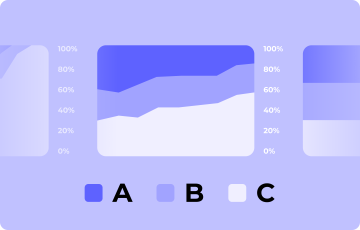
Marketing for banks: 4 strategies that work in 2023
With cyberattacks and data breaches on the rise, it's not surprising 85% of consumers are worried about cybersecurity—with identity theft and stolen credit cards topping the list of worries.
This concern puts marketers for banks in a conundrum. You know that you need consumer data to offer the personalized, curated experiences your audience wants, but you don’t want to put users’ privacy at risk.
You may be wary of embracing digital marketing innovations, fearing they might compromise your company’s security. However, a Forrester report revealed that banks willing to adapt to and utilize digital marketing grow their customer base 3.2 times faster than competitors in the financial space.
The good news is that you don’t have to choose between innovative marketing and security. This article breaks down how to embrace a number of data-driven tactics to capture the lion’s share of leads in the new year without putting consumers at risk.
1 Validate campaigns and site elements with A/B testing
You can’t assume that customers react to your messaging, website UX, and offers the way you want them to. A/B testing and experimentation allow financial services companies to make data-based decisions about what is and is not working.
Banks that use data for CX optimization grow 3.1x faster than those who don’t.
The good news is that you can build an extensive experimentation program using only anonymous and pseudonymous data. With A/B testing you can make your front-end user experience easier to use and convey the message you want.
A non-exhaustive list of on-page items you can test include:
- Headlines: If a headline clearly and concisely communicates the information in an article or landing page, scanning readers will be more motivated to continue reading. Learn what information is most important to your readers by A/B testing headlines with different writing styles and placements and seeing which variation leads to the most conversions.
- Calls-to-Action (CTAs) buttons: Test everything, from the copy and the color to the location of a CTA button. You might discover your customers respond better to “learn more” as opposed to “book a call.”
- Form fields: Test everything, from the size and color of the font to the order of questions and the level of personalization. Through A/B testing, you'll learn what information leads are willing to share, what layout is most attractive, etc.
- Copywriting: Oftentimes, financial services copywriting is full of bank-speak jargon that the average customer doesn't understand and doesn't have the time or will to decipher.
- Offers: Experiment with which offers are presented on what pages, and which offers go best together. For example, do you want to promote mortgages or a rewards program first on a personal banking landing page?
Some experimentation tools like Kameleoon also allow you to utilize AI to easily scale up your testing and segmentation, allowing you to gain more accurate results in real-time.
2 Build trust with educational content marketing for banks
Most people are walking around with a tiny computer in their pocket and reach for it to learn everything, from where to get the best pizza in town to where to buy a new winter jacket and, yes, even which financial institution should handle their money. While one in four people still prefer to meet with their bank or financial advisor in person, 86% of consumers search online first to find a bank that looks trustworthy.
A blog is a great way to build customer trust as it can break down complex information into easy-to-understand chunks. A blog with banking advice and financial updates also shows customers that you care about their financial wellbeing and don't just view them as another transaction. Make sure the information on your blog is relevant to the time of year, so you can build a reputation as a source of helpful content, for example, tips on how to start contributing to a retirement savings plan when you graduate from college. And don't neglect old blogs by letting the information get outdated.
OneUnited is an excellent example of a bank blog that knows their audience and offers up equal parts education and entertainment by covering topics from cryptocurrency to activism.
A podcast is another tool you may want to consider as a part of your overall content marketing strategy. With 60 million U.S. homes filled with avid podcast listeners, the medium is an excellent way to reach customers who may not have the time to read a blog. Consider all the people who pop in their earbuds while walking the dog or cleaning the house to listen to podcasts as they’re more conducive to multi-tasking.
Last, we can’t forget the power of social media content. Social media is a place where financial institutions can develop more intimate relationships with followers. It offers a more personal experience, especially when you make it a priority to participate in the conversations happening in the comments section.
Consumers aren’t going to share their financial info with just any organization. Win their buy-in by offering valuable resources that help them build their financial knowledge.
3 Automate direct mail marketing for banks
There’s definitely value in email and ad outreach—but many customers are overwhelmed with this messaging. Consumers’ inboxes are overflowing with marketing emails from businesses, and more than 25% of internet users use ad blockers.
Incorporate direct mail marketing in your overall content marketing plan to capture more leads and give your audience a break from digital initiatives. According to direct mail automation platform Lob, incorporating direct mail can increase conversion by 10-15%.
Financial service brands can send direct mail manually, but that process can mean hundreds—if not thousands—of hours spent and delivery errors. Consider using a direct mail automation platform instead to save time on large-scale, targeted campaigns.
Need another reason to adopt direct mail? Neuroscientist Dr. David Eagleman argues in a Sappi article that the physical touch of direct mail leaves a special impression on consumers.
"Brands that really know how to engage their customers are brands that have mastered the science of touch," says Dr. Eagleman. "They understand how to leverage haptics to create impactful marketing pieces that forge memorable and meaningful connections between brand and customer."
4 Take ownership over compliance and security
As a marketer, you might feel a bit distant from regulations—especially if your company has a separate compliance department. But in an industry like banking where consumers care so much about security, and one breach can be costly, every team member has to be cognizant of compliance—including marketers.
A more effective way to ensure compliance is to work with other departments to build a process around meeting local and global security measures, and ideally, your organization has a dedicated staff member for compliance and security who can work directly with your marketing department.
Beyond working with in-house compliance specialists, take the initiative to learn about key financial regulations, such as:
- Know Your Customer (KYC): a process banks use to identify customers to prevent bank fraud
- Non-Disclosure Agreement (NDA): a confidentiality contract for employees and vendors
- Data Loss Prevention (DLP): keeps sensitive data from leaving a secure network
- Payment Card Industry Data Security Standard (PCI DSS): a safety standard for credit and debit card data
Luckily, some marketing technology is built to comply with these regulations. Kameleoon’s platform, for example, is compliant with the EU's
- General Data Protection Regulation (GDPR) that prohibits the storage of personal information without the explicit consent of the consumer, and the
- California Consumer Privacy Act (CCPA), which enhances state residents' privacy and has the highest security standards to ensure customer information is encrypted and safe.
Focus on customer experience for financial services clients
Financial regulations are constantly changing, and consumers’ expectations of banks are evolving as they increasingly want a digital experience. Adopting a beginner’s mindset will allow you to consider more non-traditional ways of reaching your audience and finding ways to increase conversions and lead generation with A/B testing that doesn’t require you to jump through compliance hoops.
To Find out how your organization can learn more about your customers pain points and improve their online experience with A/B testing, request a demo with Kameleoon.



